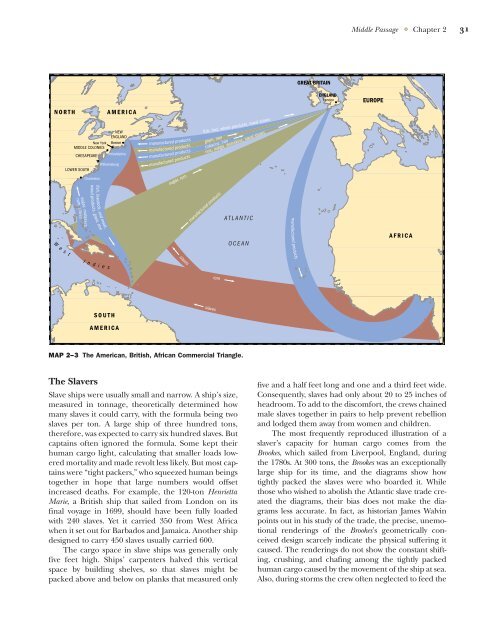You also want an ePaper? Increase the reach of your titles
YUMPU automatically turns print PDFs into web optimized ePapers that Google loves.
NORTH AMERICA<br />
NEW<br />
ENGLAND<br />
New York Boston<br />
MIDDLE COLONIES<br />
CHESAPEAKE<br />
LOWER SOUTH<br />
rum, slaves<br />
Charleston<br />
sugar, molasses,<br />
W e s tI n<br />
wood products, grain, rice<br />
The Slavers<br />
fish, livestock, and meat,<br />
Williamsburg<br />
d i e s<br />
SOUTH<br />
Philadelphia<br />
AMERICA<br />
manufactured products<br />
manufactured products grain, iron<br />
manufactured productstobacco, iron<br />
fish, furs, whale products, naval stores<br />
manufactured products rice, indigo, deerskins, naval stores<br />
sugar, rum<br />
ATLANTIC<br />
OCEAN<br />
Slave ships were usually small and narrow. A ship’s size,<br />
measured in tonnage, theoretically determined how<br />
many slaves it could carry, with the formula being two<br />
slaves per ton. A large ship of three hundred tons,<br />
therefore, was expected to carry six hundred slaves. But<br />
captains often ignored the formula. Some kept their<br />
human cargo light, calculating that smaller loads lowered<br />
mortality and made revolt less likely. But most captains<br />
were “tight packers,” who squeezed human beings<br />
together in hope that large numbers would offset<br />
increased deaths. For example, the 120-ton Henrietta<br />
Marie, a British ship that sailed from London on its<br />
final voyage in 1699, should have been fully loaded<br />
with 240 slaves. Yet it carried 350 from West Africa<br />
when it set out for Barbados and Jamaica. Another ship<br />
designed to carry 450 slaves usually carried 600.<br />
The cargo space in slave ships was generally only<br />
five feet high. Ships’ carpenters halved this vertical<br />
space by building shelves, so that slaves might be<br />
packed above and below on planks that measured only<br />
slaves<br />
manufactured products<br />
slaves<br />
MAP 2–3 The American, British, African Commercial Triangle.<br />
rum<br />
manufactured products<br />
GREAT BRITAIN<br />
ENGLAND<br />
London<br />
<strong>Middle</strong> <strong>Passage</strong> Chapter 2<br />
EUROPE<br />
AFRICA<br />
five and a half feet long and one and a third feet wide.<br />
Consequently, slaves had only about 20 to 25 inches of<br />
headroom. To add to the discomfort, the crews chained<br />
male slaves together in pairs to help prevent rebellion<br />
and lodged them away from women and children.<br />
The most frequently reproduced illustration of a<br />
slaver’s capacity for human cargo comes from the<br />
Brookes, which sailed from Liverpool, England, during<br />
the 1780s. At 300 tons, the Brookes was an exceptionally<br />
large ship for its time, and the diagrams show how<br />
tightly packed the slaves were who boarded it. While<br />
those who wished to abolish the Atlantic slave trade created<br />
the diagrams, their bias does not make the diagrams<br />
less accurate. In fact, as historian James Walvin<br />
points out in his study of the trade, the precise, unemotional<br />
renderings of the Brookes’s geometrically conceived<br />
design scarcely indicate the physical suffering it<br />
caused. The renderings do not show the constant shifting,<br />
crushing, and chafing among the tightly packed<br />
human cargo caused by the movement of the ship at sea.<br />
Also, during storms the crew often neglected to feed the<br />
31

















